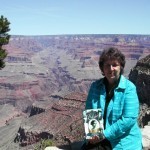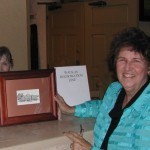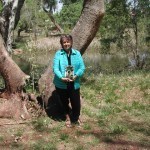Barbara Anne Waite's Blog, page 6
May 30, 2012
Elsie’s Treasured Friendships
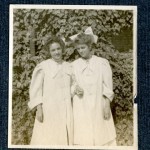
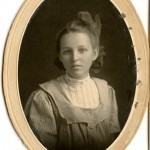
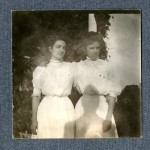
I think a good book does more than entertain us. I love to read a good historical novel and escape into another time and place for an hour before I fall asleep. I love it when a novel or a biography goes beyond entertaining and challenges me. Many biographies have challenged me to ponder my own life and my goals and habits. While writing Elsie I felt challenged to think about friendships. When I think of the friendships Elsie had I feel as if I have not had great success in pursuing deeply meaningful friendships. Living overseas has not been a help in maintaining meaningful relationships. Yet there are a few precious friends with whom, when we reconnect, it is as if we have never been apart. Elsie lost her two closest friends when they were young but I know she worked at friendships with other women through the years. Letters helped her stay connected. As a widow Elsie traveled with women friends to Hawaii and England and had delightful trips. I will add a picture here of the matching dresses that Elsie and her childhood friend Ruth wore. Ruth was buried in the dress that matched Elsie’s. I love this picture of the two girls in their matching dresses. I envy the deep friendship they treasured. My sister and I once had matching dresses as children and once again as adults. I have and treasure the “dainty work apron” that Aunt Mamie made for Elsie that says, “How doth the little Missy Bee.” Mamie wrote about the apron in a 1916 letter to Elsie that is included in the book. I want to stop and go write a note to a treasured friend. The treasure of a close friend is often not valued until it is lost.
May 12, 2012
Pioneer Living History Village Museum- Pioneer, AZ
On a recent trip we had a delightful visit with a few of the 22 outlets that carry “Elsie-Adventures of an Arizona Teacher 1913-1916.” We were in Arizona for a booksigning at Costco. One of the most interesting locations is the Pioneer Living History Museum in Northern Phoenix. It has many actual historic buildings on this large site, including an actual schoolhouse ( used from 1885-1930), a teacherage, a church, a bank and a jail. The site is well maintained with lovely wide sidewalks that seem handicap accesible. The gift shop is one that sells “Elsie.” I Include some photos here.
The territorial Museum in Yuma is a new outlet for us and also looks very interesting. Phippen Museum in Prescott is another new location for “Elsie” and is a very well done art museum. I am looking forward to returning to the Arizona Museum at Papago Park . They also now carry “Elsie.” I have been thrilled with the number of books being sold at Tuzigoot and Montezuma Castle National Monuments. Both are very interesting places to visit.
I keep thinking how Elsie would give her delightful giggle to know that her story of her Arizona years is #4 in Kindle rank for Biography /Memoir -Educator. It has been #1 for over a month in Kindle Bio/Memoir -Western. This was National Teachers Week and what an honor this is for this teacher of nearly 100 years ago to have her book selling in over 22 locations in Arizona.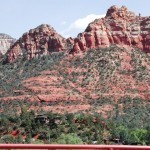
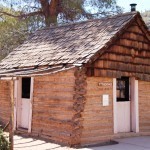
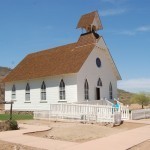
May 2, 2012
Elsie’s Cornville / Grand Canyon Sites Revisited
April 25, 2012
Ross Wheeler -Boat wrecked in 1915- Confirmation of Elsie’s story
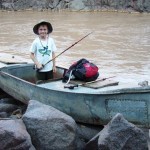
One of my favorite stories, which Elsie frequently recalled for her grandchildren, was about her “Grand Canyon adventure.” Among her papers was a yellowed newspaper article from 1915 entitled “River Scouts Have Narrow Escape.” These three men had agreed to document (on film) Elsie and a fellow teacher crossing the Grand Canyon in a wooden box attached to a cable constructed by W.W. Bass, a Grand Canyon guide. However the boat carrying the “apparatus,” as Elsie called the movie camera, was abandoned after it became stuck on the rocks as they attempted to descend the rapids of the Colorado River.
I was at Costco in Prescott, Arizona for a book signing for “Elsie” on April 14th. We spent the night with some new friends who were seasoned hikers of the Grand Canyon. I shared a copy of “Elsie” with them. As I was telling them the story of her Grand Canyon Adventure, our new friend stopped me as I mentioned the name Charles Russel, who, according to my grandmother, with another scout and a filmmaker had abandoned their boat and the movie camera when the boat was wrecked upon the rocks. He told me, “I know that boat. It’s the ‘Ross Wheeler’ and it is still down in the canyon. I have a picture of us in that very boat.” Could it be possible that the boat in my grandmother’s story was still in the canyon?
They shared a book with us that described “…the Ross Wheeler, a steel boat chained and bolted to the rock. The boat was abandoned here in 1915 by Charles Russel, August Tadje, and a filmmaker named Clements.” Amazingly, here was documentation that matched Elsie’s account of the aborted filmmaking trip! When we stopped at the Powell Museum in Page, Arizona, I discovered another interesting book, The Very Hard Way – Bert Loper and the Colorado River by Brad Dimock. Dimock’s book gave further confirmation that the wrecked
April 5, 2012
Propriety in 1913 Arizona
In my book "Elsie" the rules for teachers are explained. They were required to wear numerous petticoats (even in hot Arizona), they were not to keep company with men or "loiter" in ice-cream stores, they could not ride in a carriage or automobile with a man unless he was a father or brother, they had to be home by 8:00 p.m., etc., etc. At least in Elsie's case, judging from her diary and letters, these rules were not always enforced.
Cornville had no ice-cream parlors but some of her activities seemed to push the bounds of turn-of-the-century propriety more than ice-cream parlor dates! The two teachers lived in a small one-room shack next to the Girdner family home. Though they could not attend dances, the teachers were permitted to have young men call on them in their shack. I loved what Elsie wrote about one evening at the shack. She was sleepy, and the young cowboy Fergy was calling on Marguerite. Elsie wrote to her mother: "In a house of one room one can't go to bed when a man is calling." Apparently there was no problem for her to take long horseback and buggy rides with these cowboys. (She sat on the banks of beautiful Oak Creek and read poetry to one young cowboy and then was astonished when he declared he loved her!)
After moving to Williams to teach, the rules did not prevent her from having an active social life. She went to dinner with young men and attended moving pictures with them. She took long hikes alone with a young man on Bill Williams Mountain. In her diary she often mentioned being out late, sometimes until 2:00 a.m.!
In the introduction to my book I wrote: "As a child I always thought of Elsie as prim and proper…and old." The Wild West was maybe called "wild" because it introduced this prim and proper California college girl to a Western code of propriety. California was West of Arizona but certainly was not as "wild."
April 6 and 7th I am going to make a "wild offer." The E-book version of "Elsie" will be free on Amazon.com for those two days! I am hoping this will eventually expand to further e-book as well as print sales. So Friday and Saturday go to Amazon and "Elsie" should be free for 48 hours.
I will be doing a book singing in Prescott at Costco from 11 a.m.-2 p.m. next Saturday April 14th. I hope to visit some of our Arizona friends before we head for speaking in Utah and Nevada the following weekend.
March 22, 2012
“Interpretive History”
Webster’s dictionary describes interpretive history as: “a teaching technique that combines factual with stimulating explanatory information.”
When I was compiling Elsie I never considered that what I was creating was interpretive history. As I visited historical landmarks like Montezuma’s Castle and Tuzigoot National Park they asked me, “is this a novel or interpretive history?” I told them it was taken directly from Elsie’s letters and journals and they became excited that I had created an “interpretive history.”
Elsie’s years in Arizona were a time in history with many changes. Her journals and letters combined factual and stimulating explanatory information. Indeed it could be defined as “interpretive history.” Arizona had just become state. Elsie voted in prohibition while living in Williams. She attended women’s suffragette meetings. Disputes between Mexico and the United States were a consideration in her job choices. World War I was beginning to be news. Perhaps the more “stimulating explanatory information” would include things like Elsie’s description of her divided riding skirt weighing 30 pounds, a fellow teacher being fired for dancing “the rag,” or the fact that school was unofficially and instantly closed the moment someone announced “the creek is up!” Most history books do not include such minute detail of life in the infant state of Arizona.
I love hearing thoughts from those who have read Elsie. Recently a reader wrote, “you’ve written a wonderful book, harmonizing time/place in a very thoughtful manner… you’ve presented Elsie’s story with far greater acumen and accuracy — for which I’m grateful.” The credit must go to Elsie because only someone who was there can write of a time and place with such insight. Thank you Elsie for leaving us with your accurate and insightful look into Arizona’s history.
"Interpretive History"
Webster's dictionary describes interpretive history as: "a teaching technique that combines factual with stimulating explanatory information."
When I was compiling Elsie I never considered that what I was creating was interpretive history. As I visited historical landmarks like Montezuma's Castle and Tuzigoot National Park they asked me, "is this a novel or interpretive history?" I told them it was taken directly from Elsie's letters and journals and they became excited that I had created an "interpretive history."
Elsie's years in Arizona were a time in history with many changes. Her journals and letters combined factual and stimulating explanatory information. Indeed it could be defined as "interpretive history." Arizona had just become state. Elsie voted in prohibition while living in Williams. She attended women's suffragette meetings. Disputes between Mexico and the United States were a consideration in her job choices. World War I was beginning to be news. Perhaps the more "stimulating explanatory information" would include things like Elsie's description of her divided riding skirt weighing 30 pounds, a fellow teacher being fired for dancing "the rag," or the fact that school was unofficially and instantly closed the moment someone announced "the creek is up!" Most history books do not include such minute detail of life in the infant state of Arizona.
I love hearing thoughts from those who have read Elsie. Recently a reader wrote, "you've written a wonderful book, harmonizing time/place in a very thoughtful manner… you've presented Elsie's story with far greater acumen and accuracy — for which I'm grateful." The credit must go to Elsie because only someone who was there can write of a time and place with such insight. Thank you Elsie for leaving us with your accurate and insightful look into Arizona's history.
February 25, 2012
The “Unmentionable” Outhouse- or Blue Flowers Along the Roadside
I have been contemplating writing about the outhouses Elsie must have used in 1913-1916 in Arizona. Problem is, Elsie never ever even wrote such a word. She used to tell me that when they were riding in a wagon (3 day trip) from Long Beach to Palomar Mountain her father would of necessity stop for bathroom breaks. Only they never ever called it that. Alonzo (Elsie’s father) would say “do you girls want to go look at those pretty blue flowers over there?” That was 1904 language for bathroom break. When Elsie referred (in a letter to her mother) to “Myra (2 year old) not being very trim,” I am sure she was referring to a dirty diaper. Elsie would never have said such a word in a letter. After all in that day an outhouse was at times referred to as a “privy,” likely taken from the word private. By the time I came along my father would loudly shout out before he drained the water from our mountain cabin toilet, “potty call.” I think I like the “blue flower” language better. When our son Dan sold some of his first water-color paintings at age 15 in Antigua they were fabulous pictures of old wooden outhouses. Several of the local British ex-pats living here remarked at the art show that they wanted a copy of his wonderful “loo.” That was the first I had ever heard an outhouse referred to as a loo. Some think that came from the French word l’eau meaning water. For Elsie, writing of outhouses must have fallen under “unmentionables.” I seem to remember her using that word for a number of items not mentioned in “polite” society.
The "Unmentionable" Outhouse- or Blue Flowers Along the Roadside
I have been contemplating writing about the outhouses Elsie must have used in 1913-1916 in Arizona. Problem is, Elsie never ever even wrote such a word. She used to tell me that when they were riding in a wagon (3 day trip) from Long Beach to Palomar Mountain her father would of necessity stop for bathroom breaks. Only they never ever called it that. Alonzo (Elsie's father) would say "do you girls want to go look at those pretty blue flowers over there?" That was 1904 language for bathroom break. When Elsie referred (in a letter to her mother) to "Myra (2 year old) not being very trim," I am sure she was referring to a dirty diaper. Elsie would never have said such a word in a letter. After all in that day an outhouse was at times referred to as a "privy," likely taken from the word private. By the time I came along my father would loudly shout out before he drained the water from our mountain cabin toilet, "potty call." I think I like the "blue flower" language better. When our son Dan sold some of his first water-color paintings at age 15 in Antigua they were fabulous pictures of old wooden outhouses. Several of the local British ex-pats living here remarked at the art show that they wanted a copy of his wonderful "loo." That was the first I had ever heard an outhouse referred to as a loo. Some think that came from the French word l'eau meaning water. For Elsie, writing of outhouses must have fallen under "unmentionables." I seem to remember her using that word for a number of items not mentioned in "polite" society.
February 14, 2012
ARIZONA CELEBRATES 100TH BIRTHDAY
Feb.14th 2012- Arizona celebrates its 100th birthday today. Happy Valentines Day. I shared in the book a Valentine remembrance Elsie loved to tell about. She received a special Valentine while teaching in Arizona that was chocolate covered soap. Her chuckle when telling this story filled the room with her effervescent joy. She had a chuckle that was like none other I have ever heard. It seemed to come from her toes and traveled all the way to her heart and out her mouth filling the room with mirth.
In the book I share about Eva Girdner's memory of the first Arizona statehood celebration that occurred in Oak Creek Canyon. She shared that there were about 25 families living along the beautiful lower Oak Creek. When word arrived that statehood had been granted the Arizona territory the news was passed to all the families along the creek to meet for a picnic. The children celebrated with foot and burro races. Eva's mother made her a special red, white and blue dress for the occasion. I wonder which child had the privilege to ride his burro shouting the news of statehood and announcing the celebratory picnic. Somehow it seems that an e-mail or telephone call would never be as exciting as watching a child arriving breathless with the news that the territory was now the State of Arizona! I think "Elsie" would be a great movie. Much of what she wrote creates a vivid picture in my mind.
My Valentine arrived last evening in the form of a book order of 50 books for AZ Nat. Parks. I am also excited that in April Costco (in Prescott) has asked me to come for a book signing. I keep thinking how Elsie would be delighted with this news.
Special thanks to all who have added a review or clicked the like button on Elsie's Amazon page. I think those reviews really encourage others to buy the book. I am grateful and thrilled that all 21 reviews are all 5 star.

